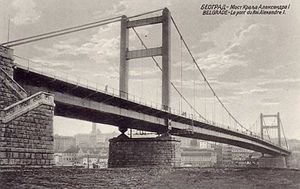King Alexander Bridge
Coordinates: 44 ° 48 ′ 53 " N , 20 ° 26 ′ 54" E
| King Alexander Bridge | ||
|---|---|---|
| use | Street | |
| Crossing of | Save | |
| place | Belgrade | |
| construction | Suspension bridge | |
| overall length | 411 m + ramp bridges | |
| width | 18 m | |
| Longest span | 261 m | |
| Clear height | 17 m | |
| start of building | 1930 | |
| opening | December 16, 1934 | |
| planner | GHH | |
| closure | On 11/12 Blown up April 1941 | |
| location | ||
|
|
||
The King Alexander Bridge ( Serbian Мост краља Александра Most kralja Aleksandra ) was a road bridge over the Save in Belgrade in what was then the Kingdom of Yugoslavia or in today's Serbia .
The bridge, opened on December 16, 1934, stood on the site of today's Brankov most and connected the port and the lively old town district of Savamala on the right bank of the Sava with the then largely uninhabited floodplain on the left bank, over which the road to Zemun ran and where the airport was.
It is named after King Alexander I Karađorđević , who ruled as king from 1921 until his death in 1934.
prehistory
As one of the victorious powers of the First World War, Yugoslavia was entitled to reparations and decided to use them for a bridge in Belgrade over the Sava. It was to be the first permanent road bridge in Belgrade after the Old Railway Bridge , which was first built in 1884 .
The Gutehoffnungshütte (GHH) agreed with the Société de construction des Batignolles (SCB), which was carrying out drainage work in the Pančevo plain at the time , that GHH would carry out the steel structure and SCB would carry out all other work, e.g. B. foundations, pillars, abutments, ramp bridges and road surfaces as well as the 4 km long access roads on both sides of the bridge.
description
The König-Alexander-Brücke was a so-called fake suspension bridge , in which the suspension ropes are attached to the deck itself and not to large anchor blocks in the ground. A similar construction, the Mülheim Bridge , had already been built a few years earlier across the Rhine .
It had a span of 261 m over the main opening and 75 m over the side arms, for a total of 411 m. This was followed by the ramp bridges.
The steel pylons had box profiles that were closed on all sides and protruded 33 m above the roadway. The bridge was 18 m wide. The two main girders of the carriageway were arranged 14.5 m apart and had an overall height of 4.30 m. They were stiffened by cross members at a distance of 6.25 m. The roadway between the pylons was 12 m wide including the two tram tracks arranged on the edge next to the pylons. The sidewalks were mounted on the outside on consoles. The total weight of the steel structure was around 7000 t. The pillars were founded with the help of caissons with a base area of 40 × 16 m to a depth of 25 m under mean water.
The bridge had a clearance height of 17 m above mean water level.
history
The construction work lasted from 1930 to 1934. Delays arose because the clearing of the shore property met resistance. In 1934 a dispute arose over the design of the bridge in the Serbian-Byzantine style . The sculptor and architect Ivan Meštrović wanted to crown large portal towers next to the entrance with a column each of an equestrian statue of four kings of Yugoslav history, which would have become almost as high as the pylons of the bridge. In the end it stayed with the portal towers.
The stress tests in mid-December were carried out under the direction of Mirko Roš , the director of the Federal Materials Testing and Research Institute . The opening ceremony on December 16, 1934 took place with great sympathy from the population.
In the Balkan campaign of World War II , Yugoslavia was attacked by the Wehrmacht on April 6, 1941 , and Belgrade was heavily bombed on that day and the following . In an attempt to stop a German invasion, all three bridges were blown up on the night of April 11-12, 1941. During the dark night it was overlooked that a ship was passing under the King Alexander Bridge, so that another 98 people lost their lives. The Wehrmacht took Belgrade on April 12, 1941. Soon after, she set up a pontoon bridge .
Web links
- Most kralja Aleksandra on staribeograd.weebly.com
Individual evidence
- ^ A b c Anne Burnel: La Société de construction des Batignolles de 1914–1939: histoire d'un déclin . Librairie Droz, Geneva 1995, ISBN 978-2-600-00094-9 , pp. 121 ( limited preview in Google Book search).
- ↑ a b Philipp Stein: 100 years of GHH bridge construction . Gutehoffnungshütte Oberhausen, Sterkrade plant, Oberhausen 1951, p. 174 .
- ↑ The total length of 467 m or 474.7 m given in the sources cannot be reconciled with a photo showing a long ramp bridge on the left.
- ↑ a b c Szavits-Nossan: Two new large bridges in Yugoslavia . In: Schweizerische Bauzeitung , Volume 105 No. 7, 1935, p. 78
- ↑ a b Most kralja Aleksandra on staribeograd.weebly.com

